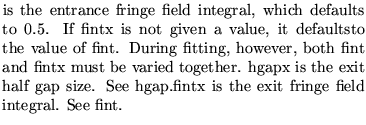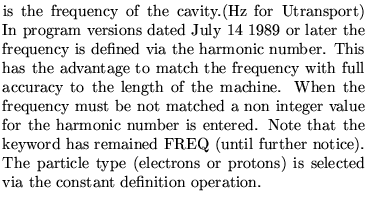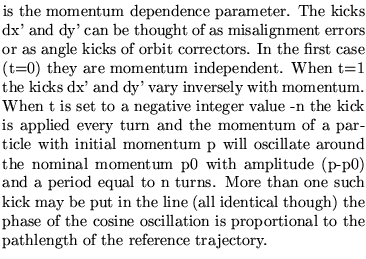drift
l is the length.
sbend
l is the length.
angle is the bend angle.
k1

e1 is the entrance edge angle.
e2 is the exit edge angle.
tilt
k2

h1 is the entrance pole face curvature.
h2 is the exit pole face curvature.
hgap

fint

rbend

quadrupole
l is the length.
k1 is the strength.
tilt
aperture is the magnet aperture for the Hardware operation
sextupole
l is the length.
k2 is the strength.
tilt
aperture is the magnet aperture for the Hardware operation
quadsext
l is the length.
k1 is the quadrupole strength.
k2 is the sextupole strength.
tilt
aperture is the magnet aperture for the Hardware operation
octupole
l is the strength.
k3 is the strength.
tilt
aperture is the magnet aperture for the Hardware operation.
multipole
l
k0 - k20 are the strengths.
t0 - t20
scalefac
tilt is the overall tilt angle.
aperture is the magnet aperture for the Hardware operation.
note1 :

note2 :

solenoid
l is the length.
ks is the solenoid strength. ks=0.5*Bs/Brho.
k1 is the quadrupole strength.
tilt
aperture is the magnet aperture for the Hardware operation.
quadac
l is the length.
k1 is the quadrupole strength
deltae

phi0
freq is the frequency of the RF in MHz.
e0 is the energy in GeV of the reference particle
tilt
aperture is the magnet aperture for the Hardware operation.
rfcavity
l is the length.
volt is the cavity voltage.(kV for Utransport)
lag

freq

energy is the energy.(GeV)
roll
angle

zrot
angle

hkick, vkick
kick a horizontal (vertical) kick of size kick,
gkick
l is the length.
dx is the change in x.
dxp is the change in x'.
dy is the change in y.
dyp is the change in y'.
dl is the change in path length.
dp is the change in dp/p.
angle
dz is the longitudinal displacement.
v

t

hmon, vmon, monitor
l is the monitor length.
xserr, not used presently
yserr, not used presently
xrerr, not used presently
yrerr not used presently
marker
ecollimator, rcollimator

l is the length.
xsize x collimator aperture
ysize y collimator aperture The default apertures are 1 meter.
arbitelm

l is the length.
p1 - p20 are the parameters.
mtwiss
l is the length.
mux, x phase advance of twiss matrix
betax, x beta value of twiss matrix
alphax, x alpha value of twiss matrix
muy, x phase advance of twiss matrix
betay, y beta value of twiss matrix
alphay
matrix
rij first order ij element of matrix
tijk